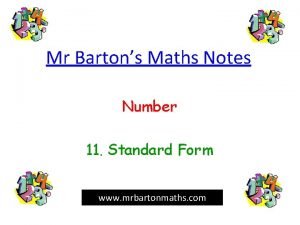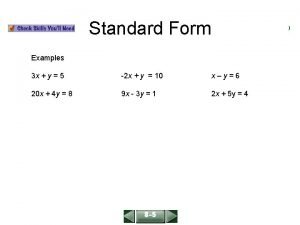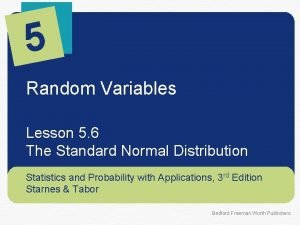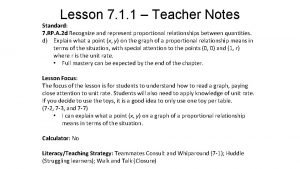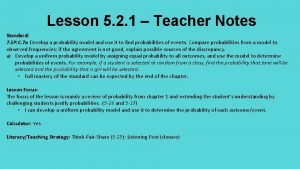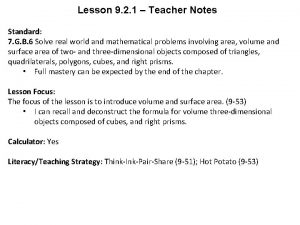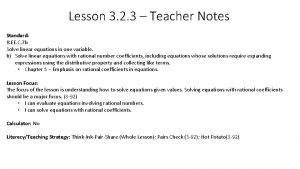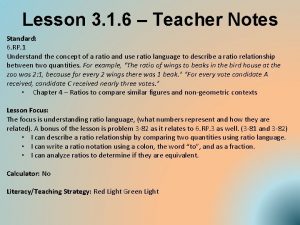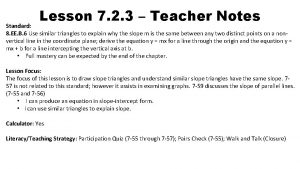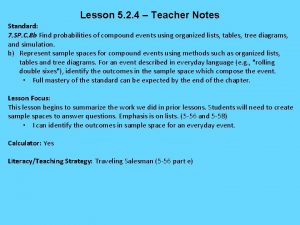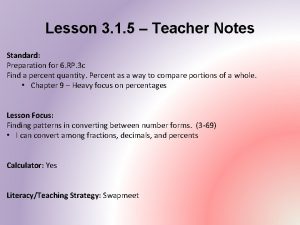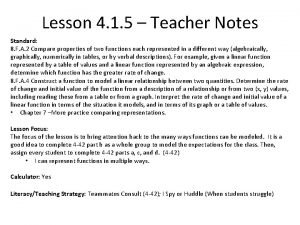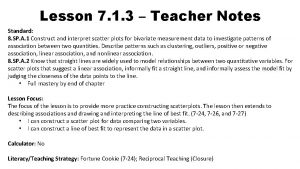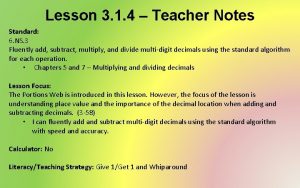Lesson 2 3 1 Teacher Notes Standard 6

















- Slides: 17

Lesson 2. 3. 1 – Teacher Notes Standard: 6. EE. 3 Apply the properties of operations to generate equivalent expressions. For example, apply the distributive property to the expression 3(2 + x) to produce the equivalent expression 6+3 x; apply the distributive property to the expression 24 x + 18 y to produce the equivalent expression 6(4 x + 3 y); apply properties of operations to y + y to produce the equivalent expression 3 y. • Chapter 6 – combine like terms • Chapter 7 – distributive property Lesson Focus: This lesson serves as a “bridge” lesson from area into generic rectangles and expressions. The ultimate goal should be to get students familiar with the generic rectangle and why it works. (2 -54) Calculator: Yes Literacy/Teaching Strategy: Turn and Talk

BELLWORK






Today you will explore an area model for multiplication. You will use what you know about place value and area to create the greatest possible product (result of multiplication). As you work with your team, keep these questions in mind: Where should we place the digits?

2 -53. Alan is working with a 1 hundred block, 5 ten blocks, and 6 one blocks. He wants to use all of these blocks to make another rectangle. a. Obtain blocks from your teacher or use Base Ten Blocks. Work with your team to help Alan arrange his blocks into a rectangle. Is there more than one way to do this? Be prepared to share. b. Sketch two of your rectangles on your paper and label their dimensions. Are the dimensions of each of your rectangles the same, or are some of them different?

2 -53. (cont. ) c. Alan labeled the dimensions of his rectangle “ 10 +2” and “ 10+3”. Why might these labels make sense? d. Which of the possible arrangements makes it easiest to see the dimensions and area of the rectangle? Contribute your ideas to the class discussion and then sketch the rectangle that you chose. e. How are the total value of the blocks and the dimensions of the rectangle related? If the one block has one square unit of area, what is the area of Alan’s rectangle? Explain at least two ways you can determine the area.

FOCUS QUESTION 2 -54. Alan has another idea. This time, he is trying to multiply 12 · 13 and get an exact answer without having to build the product with Base Ten Blocks. Alan drew the diagram below.

2 -54. (cont. ) a. Examine Alan’s diagram and discuss with your team how it relates to the shape he built with blocks. Why did he label the sides "10 + "3 and "10 + 2"? b. The shape that Alan drew is called a generic rectangle. Copy Alan’s generic rectangle onto your paper and find the areas of the four smaller rectangles. The upper-left section is already done for you. In the upper-left box, show Alan got “ 100. ” What does the “ 100” represent? Then fill in the other three smaller rectangles the same way.

2 -54. (cont. ) c. How can you find the total area represented by the entire rectangle? Work with your team to find at least two ways to do this. d. Alan would like to use the generic-rectangle strategy to do more complex multiplication problems. Work with your team to help Alan draw a generic rectangle to multiply 59 · 46 and find the product.

PRACTICE REVIEW For the problem 67 · 46, think of 67 as 60 + 7 and 46 as 40 + 6. Use these numbers as the dimensions of a large rectangle, as shown at below.

PRACTICE REVIEW (cont. ) Determine the area of each of the smaller rectangles and then find the sum of the four smaller areas. This sum is the answer to the original problem. 67 · 46 = (60 + 7)(40 + 6) = 2400 + 280 + 360 + 42 = 3082

PRACTICE Try solving these problems using the Generic Rectangle as Alan did, and check your work using any method. 1) 345 ∙ 23 2) 298 ∙ 54 3) 45 ∙ 153 4) 72 ∙ 721

HOMEWORK
 Wisc
Wisc Erf meaning
Erf meaning Good evening students
Good evening students Standard form notes
Standard form notes Standard error of the mean
Standard error of the mean What is your home language
What is your home language Difference between actual cost and standard cost
Difference between actual cost and standard cost Dskp
Dskp Standard form examples
Standard form examples Lesson 5.6 the standard normal distribution
Lesson 5.6 the standard normal distribution Lesson outline lesson 3 describing circuits answers
Lesson outline lesson 3 describing circuits answers Lesson outline lesson 3 mountain building answers
Lesson outline lesson 3 mountain building answers Lesson outline lesson 2 aquatic ecosystems answer key
Lesson outline lesson 2 aquatic ecosystems answer key Format of micro teaching lesson plan
Format of micro teaching lesson plan L 101: introduction to health care leadership
L 101: introduction to health care leadership Theme of a gift of chappals
Theme of a gift of chappals Chapter 1 lesson 1 your total health lesson 1 quiz
Chapter 1 lesson 1 your total health lesson 1 quiz Lesson outline lesson 3 weather forecasts answer key
Lesson outline lesson 3 weather forecasts answer key



